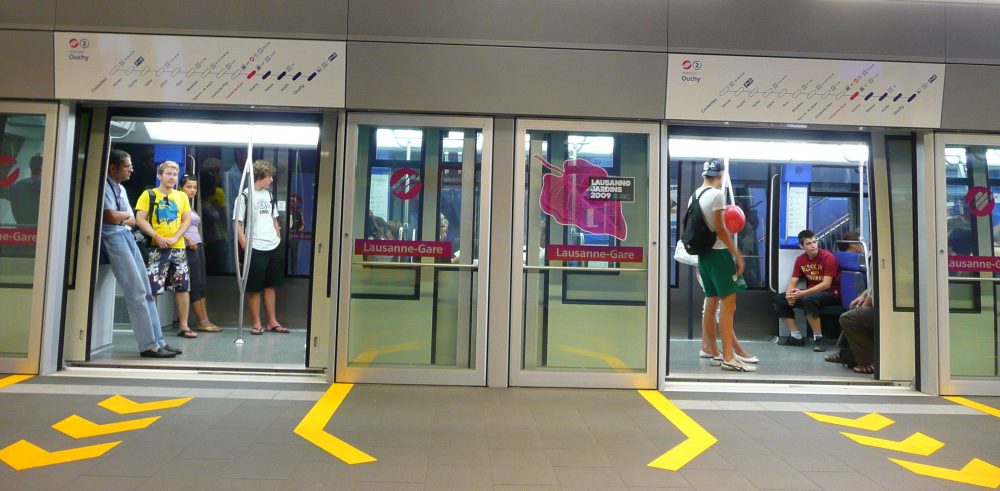Authors: Florence Chollet & Anne-Sophie Resin
Abstract
In this essay, we discuss the potential reasons behind the use of multilingual signs in relation with restaurants and grocery shops in Lausanne. Our study focuses on the area of Chauderon and Avenue d’Echallens, which are both part of the district of West Lausanne. Our research is based on six restaurants and shops which presented signs in both French and at least one foreign language. We made two hypothesis about the use of the foreign language: the first being that it was used to communicate specifically with the local population that is a speaker of the language and the second being that the foreign language was used for commercial purposes and so did not have the same communicative value to it. After analysing the pictures we took and interviewing some people affiliated with the places we visited, we separated our six restaurants and grocery shops into three categories : the ones that fit into our first hypothesis, the ones that fit into our second hypothesis and finally, the ones that did not fit in either of the categories.
Introduction
We do not often notice how many different languages surround us. In this class, we were asked to pay attention to the signs that we encounter on a daily basis (a sign is any form of written information, such as advertisement, road signs, etc…) In this essay, we focus on signs we found in relation on restaurant and grocery shop windows. Our findings are limited to the area of West Lausanne, more precisely the neighborhood of Chauderon and the street of Avenue d’Echallens. We asked ourselves what were the different reasons behind the use of different languages on these signs. A foreign language can be used as a marketing tool because it vehiculates a certain identity. For example, a restaurant with a French name implies that it identifies with the typically delicate french cuisine, which is a form of commodification. But a foreign language can also be present without impling anything other that it is there to vehiculate a message destined to the ones that understand it. For example, a Sri-Lankan owner might post advertisement written in Tamil in his restaurant because he might want to address the Tamil-speaking population specifically, not because it would help him look more authentic as a restaurator. But as we will see in this essay, the line is not always clear.
Theoretical framework
Collins, J. and Slembrouck, S. (2007). Reading Shop Windows in Globalized Neighborhoods: Multilingual Literacy Practices and Indexicality. Journal of Literacy Research.
This research was conducted in Ghent in 2007. It focuses on the perception of the readers of multilingual signs in shops, depending on their fluency in foreign and local languages. “Shop and café signs in multiple languages are familiar features of polyglot immigrant neighborhoods. What passerby make of them, how they are read, is a question rarely addressed” (Collins & Slembrouck 2007 : 335). This study helped us understand more fully the importance of personal interpretation when reading multilingual signs. Even though we cannot discuss the perception of the signs studies due to lack of data, this article reminded us that it was important to look at the demographic context of the area in which we found the signs.
Parzer, Michal, Astleithner and Rieder (2016). Deliciously Exotic? Immigrant Grocery Shops and Their Non-Migrant Clientele. International Review of Social Research.
This article shows that some non-migrants customers enjoy the culture of migrants and choose to shop in their stores because they offer a special experience. In their case, cultural differences are highlighted and celebrated. However this is to be nuanced, because “on the one hand, this can be seen as an expression of appreciation and recognition of foreign culture. On the other hand, it may also lead to the intensifying of ethnic classification and the strengthening of symbolic boundaries. “ (32)
Mankeka (2002). India Shopping: Indian Grocery Stores and Transnational Configurations of Belonging. Ethnos.
This article takes us to the other side of the counter : this study took place in California and focuses on Indian grocery shops and the meaning that they carry. For one woman interviewed “Language and food are two ways to retain our culture” (83). The researcher explains that “Indian grocery stores form a crucial node in the transnational circulation and consumption of commodities and discourses about India”. (92) Or, as an Indian shop owner said “people don’t just come here to buy groceries. They come here for the whole package.” (80)
Magninin, Miller, Kim and all. (2011). The Psychological Effects of Foreign-Language Restaurant Signs on Potential Diners. Journal of Hospitality & Tourism Research.
This study took place in the United-States, where 105 college students were asked to comment on a restaurant that they visited through photos. They all saw the same restaurant (which was decorated as a typical mexican restaurant), except for the exterior sign: half of the students were shown it English and the other half in Spanish. The same process was repeated with a Korean restaurant that was presented with with a sign in Korean or in English to test the reliability of the first experiment. The participants were asked to rank on a scale from 1 to 10 different traits concerning the restaurant’s brand personality and the authenticity of their food.
Jang, Liu, Namkung (2011). Effects of authentic atmospherics in ethnic restaurants: investigating Chinese restaurants. International Journal of Contemporary Hospitality Management.
These researchers studied the effects of language and authenticity related to their dining experience in a Chinese restaurant. Through surveys, they asked participants if an authentic chinese ambiance would affect positively their dining experience and looked for a link between positive emotions and positive behavioral intentions, which could be all linked to a positive authentic experience. This study encouraged us to search for restaurants that presented as authentic and look for elements that would emphasize this feeling, particularly in the written and/or oral use of a foreign language.
Contextualisation
For this research, we focused on two different geographical areas: Avenue d’Echallens and Chauderon. The Avenue d’Echallens belongs to the Maupas/Valency neighbourhood and Chauderon belongs to the Centre neighbourhood[1]. Consequently, both are situated in West Lausanne. The type of institutions we targeted are restaurants and grocery stores that presented linguistic characteristics from other countries, cultures and ethnies.
One of the main reasons why we chose these specific neighbourhoods is because we knew their typical characteristics, since we are both residents of Lausanne and thus could find there plenty of grocery stores and restaurants selling products from other countries. Consequently, we started our collection of data on that basis and found lots of institutions that matched what we were looking for in those precise areas.
The Avenue d’Echallens is located in West Lausanne. This avenue bounds Chauderon to Prilly, a municipality located on the borders of the city. The LEB (Lausanne Echallens Bercher railway) passes by this street since 1873[2]. Since the installation of the railway, many accidents occurred. For this reason, the authorities of Lausanne decided to build a tunnel to secure the Avenue d’Echallens. The processus is already under way and will last until 2020, which causes an increase in traffic on that Avenue. Concerning its demography, the number of inhabitants is estimated at 3’872.
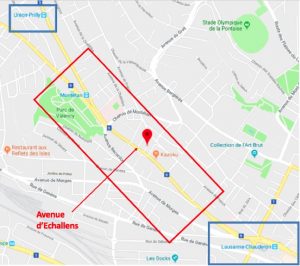
Chauderon, as the Avenue d’Echallens, is located in West Lausanne. This area is really important for the city since the edification of the Pont Chauderon in 1905 and the construction of Avenue de Beaulieu in 1912. Indeed, at the beginning, Chauderon was simply a little square with a fountain until it became an important crossroad for public transports, trade and business.[3] This neighbourhood connects (through Avenue des Terreaux) to Bel-Air and (through Avenue d’Echallens) to Prilly. Furthermore, the Pont Chauderon is essential since it facilitates traffic to the main train station. Regarding its demography, Chauderon has approximately 2’148 inhabitants.
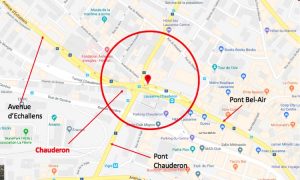
West Lausanne covers many municipalities and includes Avenue d’Echallens and Chauderon. Consequently, the following statistics, from the Official Lausanne website, provide overall information concerning the social background and the percentage of foreign population in the West Lausanne area.
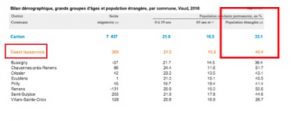
According to that information, 45,4% of West Lausanne permanent population has a foreign nationality. This indication allowed us to estimate that the areas in which we collected our data would present approximately the same percentage of migrant population.This proportion of migrants might justify or at least be one of the main factors explaining the great numbers of grocery stores and the high concentration of restaurants presenting foreign linguistic characteristics.
As follows, the statistics of the overall population provide an overview of the main nationalities in Lausanne. Therefore, the chart shows a majority of migrants coming from the European Union; a majority of French followed by Portuguese, Italians and Spanish. The proportion of Africans is much lower as well as the number of North Americans. However, the Latino Americans and Asians are more numerous.
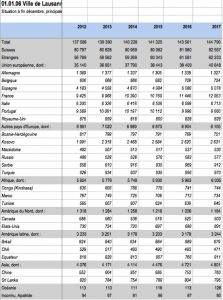
[1] https://fr.wikipedia.org/wiki/Liste_des_quartiers_de_Lausanne, accessed on 20.05.2018
[2] http://www.leb.ch/ligne-verte/un-peu-d-histoire.html, accessed on 20.05.2018
[3] http://www.notrehistoire.ch/medias/46200, accessed on 28.05.2018
Methodology
As we were collecting data, we walked around central Lausanne, paying close attention to our surroundings. We noticed a lot of foreign-language signs on restaurants showcases, menus and grocery shops windows. We realised that there was an interesting link to study between culture, language and cooking, and decided to start collecting our data with this focus.
Before starting to write, we looked at what others had already done. Many linguistic studies had been conducted on multilingual signs and even the influence of foreign languages on the dining experience of customers. Relying on these previous studies, we started situating our research question.
Later on, we faced difficulties finding data about the languages spoken in our chosen area. Instead, we found some data about nationalities in Lausanne from which we made an hypothesis about the languages spoken. Nevertheless, it is important to note that nationality does not equal language.
Results
We chose to analyse the signs corresponding to six different grocery stores and restaurants located in Avenue d’Echallens and Chauderon which are:
1) “Café Restaurant Chinois Dongpo”
2) “La Nonna Restaurant”
3) “McDonald’s Des Terreaux”
4) “Restaurant Gambatté”
5) “Anonymous Grocery Store”[1]
6) A grocery store whose name we could not translate from Sri-Lankan
Analysis of the signs
Concerning the distributional pattern of languages, on “Café Restaurant Chinois Dongpo”‘s showcase and the two restaurant signs, one can notice big red chinese symbols. French only appears once (in black) to indicate the name of the restaurant but is complemented by chinese symbols. French is only written on the slate to indicate the daily menu, in a non-permanent way. We also find the german name Feldscholössen on top of the chinese name of the restaurant, as well as a « wifi » sign on the window.
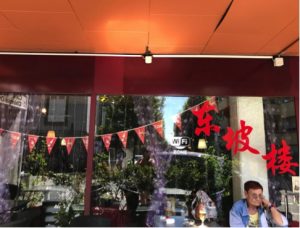
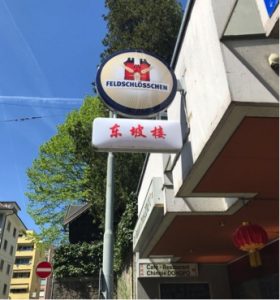
[1] The staff we met at this store did not wish to participate in the study, so we decided to anoymize the store’s name and delete its location on the map
Regarding “La Nonna Restaurant”, Italian is present in the name of the restaurant and on the menu. French and Italian are equally distributed : almost everything is translated in both French and Italian: name of dishes, type of meat and complementary information. However, the opening hours are only written in French.
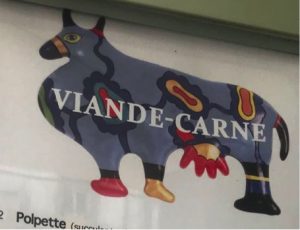
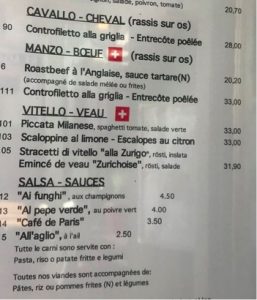
“McDonald’s des Terreaux” presents interesting features, such as the use of English words in French phrases. English appears in big capital letters and French is used in smaller font.
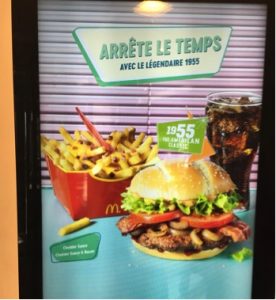
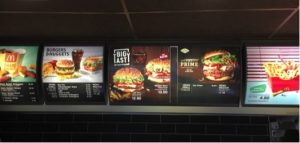 “Restaurant Gambatté”’s main sign on the entrance is written in French only. On the showcase, the logo is written in both French and Chinese. However, as soon as one enters the restaurant, the only language that appears is Chinese : on the walls, boards and decoration.
“Restaurant Gambatté”’s main sign on the entrance is written in French only. On the showcase, the logo is written in both French and Chinese. However, as soon as one enters the restaurant, the only language that appears is Chinese : on the walls, boards and decoration.
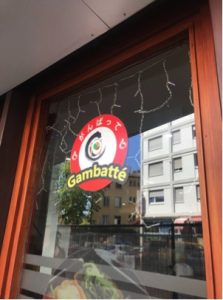
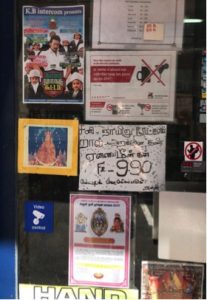
The « Anonymous Grocery Store » presents English, Tamil and French. On the sign of the shop, the three languages appear. On the showcase, English and Tamil are written in color and in a bigger font than French. A handwritten note, advertising for Sri Lankan movies and other documents in Tamil are fixed on the door on the third picture.

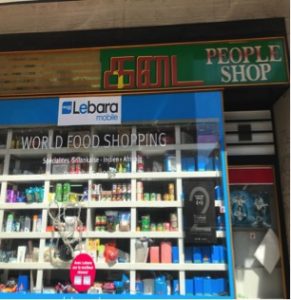
The last shop we focused on is a Sri Lankan grocery shop. On the showcase, the only language that can be found is Tamil. On the door, a note in Tamil and another one in French is fixed. The name of the shop and what is sold here is not explicit in French.
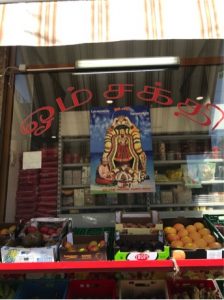
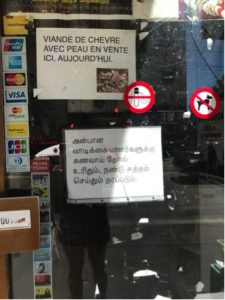
Interviews with owners and employees
At the “Restaurant Chinois Dongpo”, an employee we interviewed told us that most people that work there are Chinese. She simply said that it made sense to have a typical chinese decoration in the restaurant.
“La Nonna Restaurant” shows an equal distribution of both languages. When we asked why they used both Italian and French on their menus, the owner answered that it made more sense to write down the original names since they were serving Italian dishes. He also mentioned that Italian people felt more welcome here because of that.
“McDonald’s des Terreaux” was easier to investigate because we both happen to work at McDonald’s. We asked our managers the reason why English was used so much on our displays and menus. We were told that one of the objectives of the brand is to be very consistent, so that a customer knows that he or she could have almost the same experience anywhere in the world. Therefore, McDonald’s uses English for all of its products to emphasize its American origin (which is an important part of it’s marking identity) but also to remain consistent and accessible.
In “Restaurant Gambatté”, only the main sign is written in French. We asked one of the employee why there was Chinese written on the walls. She replied that the inscriptions were in traditional chinese, which is typically used for decorative purposes. She added that the owners, a chinese couple, enjoyed having it in their restaurant.
The “Anonymous Grocery Store” showcases manifests an unequal use of English, Tamil and French. As we were taking pictures of the shop, the owner got out and showed us that she did not want us to take pictures. We tried to explain that it was for a study in the context of the University of Lausanne and asked why she fixed notes and posters in Tamil on the door but she did not understand, since she almost did not speak French at all.
The Sri Lankan grocery shop does not provide any information in French, except a note fixed on the door: French-speaking people cannot figure out what kind of items are sold there, unless they look through the showcase. The hierarchy of languages is clearly defined (Tamil over French) and the distribution of languages is unequal. The cashier told us that the reason why the majority of the information is written in Tamil is because he knows that there is a Tamil-speaking population here and that he wanted to address them directly through their language.
Discussion
The following restaurants fit into our first hypothesis, where the use of a foreign language is for communicative purposes. It is a way for the owners to communicate with the inhabitants of Lausanne that also speak their language. These restaurants or grocery shops do not necessarily exclude the people that cannot understand their language, however some messages are simply not directed to them.
“Restaurant Chinois Dongpo” undoubtedly addresses a Chinese community since the majority of the information is provided in Chinese. The languages are unequally distributed and some complementary information does not have its translation in French. However, the Restaurant does not exclude a potential French-speaking population since the price and details of take-away meals are explicitly written in French on the board at the entrance.
The general prominence of Tamil on the showcase and on the door of “Anonymous” and its use to provide broader and cultural information demonstrate that it targets Tamil-speaking customers. However, French and English-speaking customers are not excluded, since they can understand what is sold in the shop. The linguistic norms of French are, still, incorrect, which could mean that the owner itself may not speak French very well. This hypothesis was confirmed by our interaction with the owner of the shop that forbid us to take any more pictures.
The Sri Lankan grocery store we analysed corresponds to our first hypothesis. French is hardly present on the windows and was not spoken by the employee we talked to. Instead, numerous inscriptions (only in Tamil) advertise for different products, such as fresh crabs and squids. The fact that Tamil is not written in latin alphabet makes it very inaccessible to French speakers, which brings us to the conclusion that it’s presence here is a tool for targeting the Tamil-speaking population of Lausanne.
The following restaurants fit into our second hypothesis, where foreign languages are used as a marketing tool. The foreign language is often chosen for its associated imagery and aesthetic. Being understood by the speakers of the language is not the main purpose behind its presence.
The “McDonald’s des Terreaux” corresponds to our second hypothesis. It is obvious that McDonald’s is not some kind of authentic restaurant of American tradition; it is a widely-spread chain of fast-food. McDonald’s, as the general manager we interviewed said, prides itself in being accessible and consistent. Although the use of English might contribute to the American ambiance of the fast-food, it is hardly the point.
“La Nonna Restaurant” undeniably corresponds to our second hypothesis. Even if it provides an equal distribution of French and Italian, the owner demonstrated that Italian is used as a commercial tool since they consciously want customers to associate Italian dishes’ names with authenticity as soon as they read the menu. Moreover, the fact that Italian appears before its translation in French indicates a conscious will to put the restaurant’s authenticity in the forefront.
Finally, the following restaurants are the ones that did not fit into either of our hypothesis. The first reason is that we cannot know for certain what the ideas of the owners of the restaurants or shops were due to lack of reliable data. The second reason is that in some places, a foreign language served a double purpose : addressing its speakers while still serving as a marketing tool.
The results concerning Restaurant Gambatté correspond to a cross between our first and second hypothesis. Firstly, the restaurant appeals to a Chinese population since the name of the restaurant and more details about what it served is provided in Chinese, which coincide with hypothesis 1. However, the use of French on the showcase, the menus and the main sign also appeals to a French-speaking population.
Furthermore, the singular use of traditional Chinese, used only for symbolic purpose as the owner said, alongside the traditional Chinese music that is played inside the restaurant serve a marketing function: it emphasizes the authentic look and environment of Restaurant Gambatté. According to this, we could establish a connection to a previous study, which results corresponds to our findings: “Effects of authentic atmospherics in ethnic restaurants: investigating Chinese restaurants” by Jang, Liu, Namkung. The results show that “Chinese menu presentation and Chinese music were important determinants of both types of emotions” (12) and show a general tendency to more positive emotions in an environment that is judged authentic.
Conclusion
The different restaurants and grocery stores we analysed belong to three different categories: in the first category, a foreign language (which most often does not use the latin alphabet) is used authentically to address its speakers on purpose. In the second, it is used as a marketing tool and in the third, it is a combination of the two: it addresses the respective speakers while serving a marketing function.
Some of the limitations we faced concerned the sociopolitical and linguistic background of these areas because we could not find revelant engough information. The statistics from the Ville de Lausanne did provide numbers concerning the nationalities of the inhabitants, but no data concerning the languages they speak.
Since we focused on two small areas, it would have been interesting to target a larger zone, thus creating a larger database including more restaurants and grocery shops presenting linguistic characteristics from other countries.
We would have also liked to have more in-depth conversations with the owners of the shops and restaurants in order to learn more about their actual intentions behind the use of certain languages. During out data collection, it was hard to find the owners, or simply anyone willing to talk to us. With more reliable information, we could have learned more about multilingualism in the world of restauration.
Bibliography
Collins, J. and Slembrouck, S. (2007). Reading Shop Windows in Globalized Neighborhoods: Multilingual Literacy Practices and Indexicality. Journal of Literacy Research.
Jang, Liu, Namkung (2011). Effects of authentic atmospherics in ethnic restaurants: investigating Chinese restaurants. International Journal of Contemporary Hospitality Management.
Mankeka (2002). India Shopping: Indian Grocery Stores and Transnational Configurations of Belonging. Ethnos.
Magninin, Miller and Kim (2011). The Psychological Effects of Foreign-Language Restaurant Signs on Potential Diners. Journal of Hospitality & Tourism Research.
Parzer, Michal, Astleithner and Rieder (2016). Deliciously Exotic? Immigrant Grocery Shops and Their Non-Migrant Clientele. International Review of Social Research.
